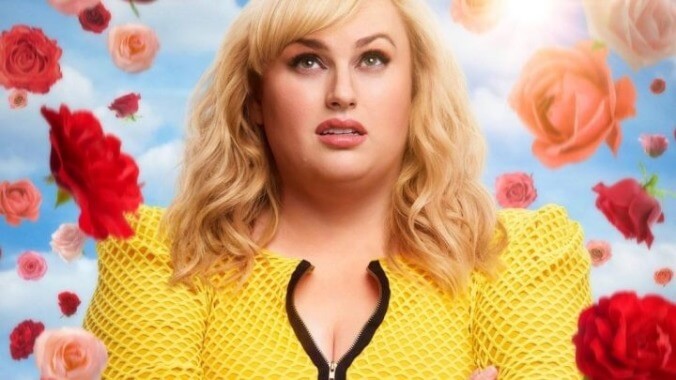Have a love-hate relationship with rom-coms? Then Isn’t It Romantic is for you

To be sure, the truly hardened cynic will find plenty to pick apart in the new Rebel Wilson-led rom-com, Isn’t It Romantic. But such committed misanthropes, by definition, don’t enjoy much of anything. On the other extreme, the doe-eyed and optimistic will like the film—which extensively employs romantic-comedy tropes in the service of satirizing them, thus having its mini cupcakes and eating them, too—just fine. But the real audience for Isn’t It Romantic is a different demographic altogether: It’s a feature-length in-joke for fans who will always pause if My Best Friend’s Wedding pops up during a lazy Saturday afternoon channel-surfing session, but who ultimately consider rom-coms a slightly shameful guilty pleasure.
What that means for Isn’t It Romantic’s theatrical prospects is unclear, particularly when combined with negative press surrounding Wilson’s incorrect assertion that she is the first plus-sized woman to lead a studio romantic comedy—and, more importantly, her inept handling of the backlash against said assertion. (As Queen Latifah fans already know, Wilson is simply the first white woman to do so.) It’s a bold move, aiming a movie at an audience that generally only consumes this type of entertainment hungover and in sweatpants. Isn’t It Romantic seems hyper-aware, even anxious, about not overstaying its welcome, clocking in at a brisk 88 minutes and frequently pausing to re-state its core thesis that rom-coms are dumb, and the audience is smart. It’s as noncommittal as its lead, Natalie (Wilson), a New York City architect (don’t worry, that’s part of the joke) who doesn’t end the film a different person than she was at the start—and that’s one of the best things about it.
We open with a scene reminiscent of Amy Schumer’s Trainwreck, as a young Natalie is advised by her chain-smoking, boxed wine-drinking mother (Absolutely Fabulous’ Jennifer Saunders) that the best she can ever hope for is that someone might want to marry her for a visa. Smash-cut to present-day New York City, and Natalie’s tiny, dim studio apartment. After a particularly discouraging day at work where a wealthy client (Liam Hemsworth) asks her to fetch coffee mid-presentation, she gets accosted by a stranger on the subway who tries to steal her purse. Finally reaching her breaking point, Natalie fights back, and ends up smacking her head hard against a metal subway pole. When she wakes up in the hospital, she knows something is wrong: Her doctor is way too hot, there are way too many flowers in her room, and the street outside is way too quaint and colorful. “New York doesn’t smell like shit anymore,” she notes suspiciously. When the same client who dismissed her the day before pulls up in his stretch limo and asks her on a date, she begins to suspect what an impromptu dance number on Central Park confirms: She’s stuck inside a romantic comedy, and a PG-13 one at that.
The basic premise of the film is in the same general meta-comedy mold as Drew Goddard’s The Cabin In The Woods, albeit a less imaginative version of the same. Goddard’s film took an expansive view of horror tropes, pulling back with each plot twist until the story took on cosmic proportions. Conversely, the all-female writing team behind Isn’t It Romantic—Significant Mother co-creator Erin Cardillo, Set It Up writer Katie Silberman, and How To Be Single and The Wedding Date writer Dana Fox—treats rom-com tropes as a sort of bon mot batting cage, evoking and then dismissing them one by one with focused, frequently laugh-out-loud one-liners. (Natalie’s quip that, as a boss, she’s “tough but fair—like my leg hair,” got an especially hearty laugh at my preview screening.) The script also has some trenchant observations on women in the workplace, gay stereotypes, and the invisibility afforded to Natalie by her weight: “Guys look at me in the eyes!” she exclaims after she’s transported to rom-com Oz. She’s not used to being seen.
Wilson’s body type is an unspoken but essential element of both the film’s humor—alas, there are a couple of fat jokes at the beginning—and its commentary on cinematic tropes. When she says “girls like me” don’t get special treatment, we know exactly what she means. And the film takes pains not to paint Natalie’s body as a “before,” and to underline that it’s not her weight that’s keeping her alone; it’s her unwillingness to be vulnerable. (This earnest intention makes one of the film’s big twists extremely obvious early on, but they mean well.) Wilson, as always, is down for anything physical-comedy-wise, a talent that really shines in a remarkably well-executed Mamma Mia!-style dance number midway through the film. But the real surprise in her performance, perhaps because she doesn’t get to play a romantic lead very often, is her ability to turn romantic chemistry on and off as a scene demands. The rest of the cast, including Priyanka Chopra as a haughty self-proclaimed “yoga ambassador” and Betty Gilpin as a meek officemate, all fall into the “purely supporting character with no life of their own” mold—but in this film, that may well have been intentional.
Director Todd Strauss-Schulson, who also helmed the underrated A Very Harold & Kumar 3D Christmas, goes a little overboard with the sweeping camera movements, but shows great acuity for reinforcing the humor in the script with visual and auditory jokes like the detailed street signs (one parking sign reads, “Now-Eternity, ’Til Death Do You Part”) and a reoccurring musical bit involving Vanessa Carlton’s “A Thousand Miles.” By the end of the movie, the line between satirizing and indulging in rom-com cliché has become nonexistent, and a second dance sequence at the end of the film tips the balance toward unintentional cheese. But that’s okay, because if you cared enough to put on pants and leave the house to go see Isn’t It Romantic, you’re probably down for a bit of schmaltz. Even if you don’t want to admit it out loud.